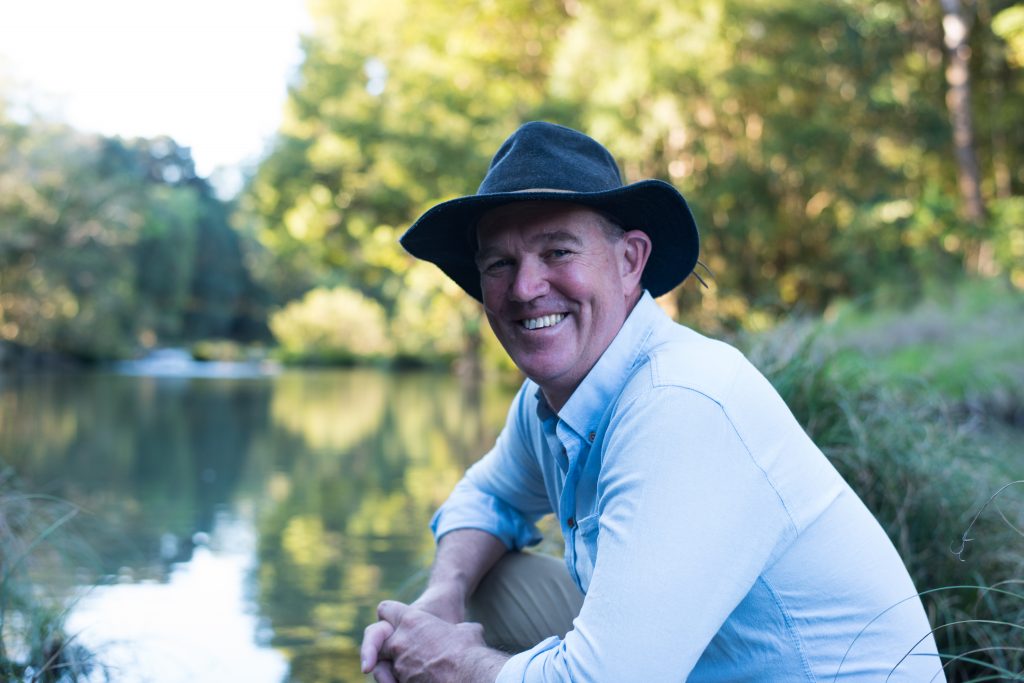A research project 20 years in the making to restore a dynamic creek system in NSW’s Hunter region has yielded fantastic results for the environment and all involved.
Griffith University’s Associate Professor Andrew Brooks started on the experiment to stabilise the creek that ran through Brian Woodward and Sally Middleton’s property in 2001.
Since then, under Associate Professor Brooks’ guiding expertise and the support of the NSW Government and Hunter Local Land Services, the natural interventions put in place have seen the waterway remain a healthy and robust ecosystem, even through major flooding and bushfires.

Brian and Sally have lived on Stockyard Creek in the Hunter Valley for 45 years. Their property was previously heavily grazed with little vegetation, particularly in the creek. Brian’s initial attempts to stabilise the creek fell short.
“Our first action was to not have stock on the property, and we spent a number of years clearing weeds and planting native indigenous species,” Brian said.
“Our planting was stabilising the banks, but the creek bed still wasn’t stable, and it was starting to erode. So, we wanted to investigate what to do about that and Andrew Brooks, who was a researcher at Macquarie University in Sydney [at the time], was looking at changing the attitude of river managers.”
Associate Professor Brooks was at that time doing research into the role that large woody debris (logs the naturally fall into creeks and rivers) played in channel form and stability.
“I did work down in East Gippsland in Victoria, where there were rivers that were still full of their natural woody debris load – 30% of the bed was made up of wood,” he said.
“At the time when we first came here, Brian had been working on it for 20 or so years to revegetate, but most of the vegetation was on the banks. Some wood had started falling into the channel, but Brian was concerned that it was going to cause erosion, so he’d been tending to pull it out.
“So, what we wanted to do at that point was encouraged the wood to stay in the channel, but also to add a whole lot of additional wood.”
Associate Professor Brooks explained that a that time it was still standard practice amongst land owners and government agencies to pull logs out of rivers in the mistaken belief that they caused erosion and flooding.
The goal at that time was to change this practice and demonstrate that logs were actually an essential functional element of streams that were good for aquatic habitats (in a direct sense) and were essential for the form and stability of whole creek and river systems.
“In Australia up until the 1990s, we had been diligently pulling all logs out of rivers ‘to tidy them up’ to improve navigation, remembering that in the early days of colonisation the rivers were the main transport routes,” he said.
“They were also assumed to make floods worse – so wood removal (desnagging as it was known) was one of the primary activities of river managers undertaking flood mitigation works.
What we now know is that removing the logs and riparian vegetation (which created hydraulic roughness) caused the channels to erode and made floods worse downstream, which is where it mattered most on the towns along the lower reaches of many rivers.”
Associate Professor Andrew Brooks
Over the course of the proceeding months, Associate Professor Brooks and his team built 26 structures, comprising over 200 logs across a one kilometre reach of the creek, which created large pools downstream and maintained sediment upstream.
Despite numerous floods over the last ~ 20 years, the Black Summer bushfires in 2019 and major flooding that followed in the years after, the structures maintained their integrity and kept the creek stable. This is because, in keeping with how natural systems work, a large proportion of the introduced logs were buried with the creek bed and into the floodplain on either side of the river.
“The log structures are like icebergs – in that only about 10% of the logs are visible when we finish the installations,” Associate Professor Brooks said.
Gavin Farley from Hunter Local Land Services and Rhiannon Hughes from Soil Conservation Service became interested in the works that had taken place along Stockyard Creek and in 2022 undertook a study 20 years post-construction.
“I was lucky enough to be an honours student with Andrew Brooks and was very familiar with this river reach, having undertaken a geomorphic assessment 10 years after the logjams were constructed,” Hughes said.
“What we found [at Stockyard Creek] was that even though 60% of the log structures had experienced fire damage, the river reach was still showing geomorphic diversity and stability.
“There was natural wood recruitment from the surrounding landscape, and we had these geomorphic features that had been formed in association with the logs, had recruited natural vegetation and that was still stable, even post-fire and flood.”
Rhiannon Hughes, Soil Conservation Service
Associate Professor Brooks said without having any wood in the creek created a bed that was constantly mobile.

“The strategy that was at the heart of this experiment was to return to the materials that nature intended and that these rivers – and the biota that live within and around them – had evolved with over millenia. In essence, we are helping to ‘re-wild’ rivers with the elements that have been missing for the last 100-150 years,” he said.
“So by creating these stable hard points, we create opportunities for vegetation to stabilise but we also create opportunities to create scour pools and get more complexity into the creek bed. These pools create the habitat diversity that underpins the aquatic and riparian ecosystems in this creek.
“We can actually reduce the flooding downstream by increasing the amount of roughness in the channels. And that’s what we’ve got here, it’s slowed the flood waves down by taking the energy out of the floods, and it’s delaying its arrival further downstream and reducing the amount of erosion it causes along the way.”
All acknowledged that the investigation had been an important lesson to see how a vegetated and wood laden river reach can bounce back after a sequence of extreme events.
“This sort of resilience in our rivers and streams is what we are going to need a lot more of as we confront increasing numbers of extreme events under a changing climate.”
Associate Professor Andrew Brooks
Hunter Local Land Services thanks property owners Brian Woodward and Sally Middleton, Associate Professor Andrew Brooks from Griffith University, and Rhiannon Hughes from Soil Conservation Service for their involvement. The video was produced by Hunter Local Land Services.




